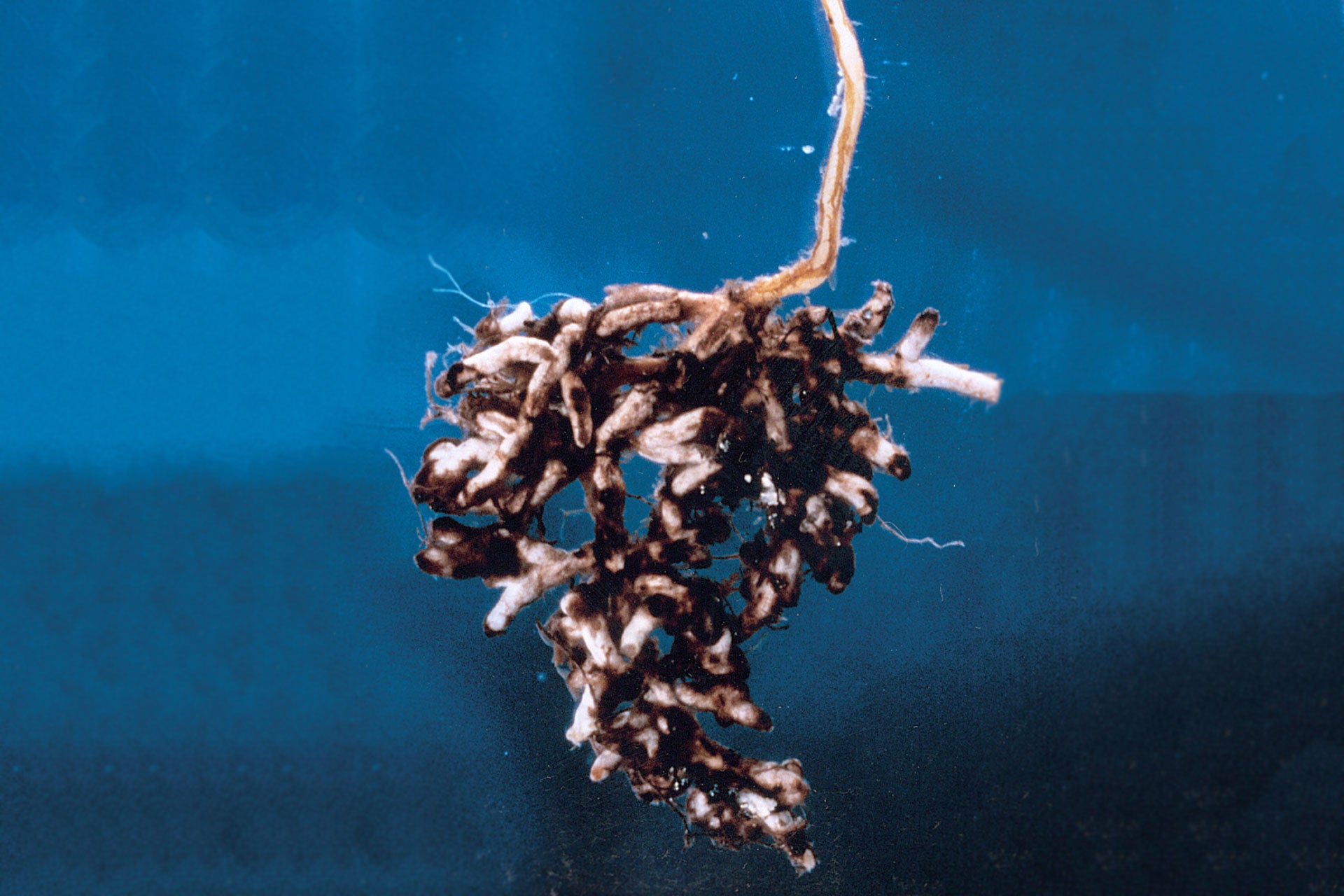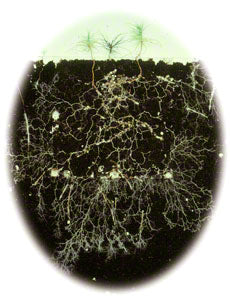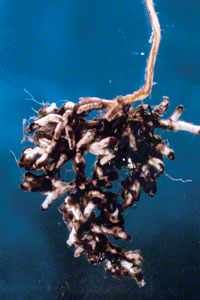
Mycorrhizal Management
A Look Beneath the Surface at Plant Establishment and Growth
by Michael P. Amaranthus, Ph.D.
This article originally appeared in The Spring 1999 issue of Florida Landscape Architecture Quarterly, reprinted with permission from the author.

Little things run the world. This is especially true when it comes to getting plants established. Under natural conditions plants live in close association with soil organisms called mycorrhizal fungi. These fungi colonize plant roots and extend the root system into the surrounding soil. (Figure 1.) Estimates of amounts of mycorrhizal filaments present in healthy soil are astonishing. Several miles of filaments can be present in less than a thimbleful of soil associated with vigorously growing plants. The relationship is beneficial because the plant enjoys improved nutrient and water uptake, disease resistance and superior survival and growth.
Nearly all commercially produced plants form mycorrhizae and require the association for maximum performance in outplanted environments. (Figure 2). This not-so-glorious association between plants and mycorrhizal fungi is fundamental to plant establishment and growth.

Depending on the environment in which they are growing, plants may divert up to 80% or more of the net energy fixed as sunlight to below-ground processes. Some of this energy goes into root growth; but, a high proportion may be used to feed mycorrhizal fungi and other soil organisms. This is not energy that is lost to the plant. On the contrary, soil organisms living in the root zone greatly influence the ability of plants to establish through effects on nutrient cycling, pathogens, soil aeration, and soil water uptake. Of the various soil organisms that benefit plant establishment, the most is known about mycorrhizal fungi. Roughly 90% of plant species are thought to form mycorrhizae: the combination of fungal and root tissue is called the mycorrhiza and the fungal partner is termed a mycorrhizal fungus.
Commercial production of mycorrhizal fungi for practical use has been available in the last decade, however, the importance of mycorrhizal fungi has been evident for some 400 million years. The earliest fossil records of the roots of land plants contain evidence of the fossil remains of mycorrhizal fungi. Scientists now believe that the "marriage" of mycorrhizal fungus and plant played an essential role in the evolutionary step which brought aquatic plants from sea to land. At some point in the evolutionary process, a filament penetrated into the outer cells of a primitive plant root. Once there, it accommodated itself so nicely that a new, more complex entity emerged, the mycorrhiza. The increased absorbing area provided by an elaborate system of fungal filaments allowed aquatic plants to leave the marine environment and exploit a relatively harsh soil environment.

Figure 3: construction sites typically compact the soil and remove organic matter and topsoil. These practices reduce or eliminate mycorrhizal fungi.
n today's man-made environments plants can be greatly stressed and the relationship between fungus and root is critical. Unnatural conditions such as concrete, asphalt, roadsides, sidewalk cut outs, trenching, drain fields, air pollution, shopping malls, business districts, and suburban developments adversely effect the presence and abundance of mycorrhizal fungi.
Man-made environments often suffer from compaction, top soil loss, and the absence of quality organic matter, conditions which reduce the habitat necessary for the mycorrhizal fungus to survive and thrive (Figure 3). Artificial landscapes effect the mycorrhizal relationship in two fundamental ways. First, they isolate the plant from beneficial mycorrhizal fungi available in natural settings and, secondly, they increase plant stress and the need for water, nutrients, and soil structure mediated by their below-ground "partners".Fortunately, recent advancements in mycorrhizal research and application have made landscape applications with mycorrhiza easy and inexpensive. New products and knowledge result in increased transplant survival and lower long-term maintenance. However, to be successful the landscape contractor requires an appreciation of fungi beyond itchy toes and moldy bread.
How do mycorrhizal fungi work?

Figure 4: "cut-away" view of the root structure of conifer seedlings, enhanced and extended by a network of mycorrhizal filaments.
Mycorrhizal root systems increase the absorptive the absorbing area of roots 10 to 1000 times thereby greatly improving the ability of the plants to utilize the soil resource. (Figure 4). Mycorrhizal fungi are able to absorb and transfer all of the 15 major macro and micro nutrients necessary for plant growth. Mycorrhizal fungi release powerful chemicals into the soil that dissolve hard to capture nutrients such as phosphorous, iron and other "tightly bound" soil nutrients. This extraction process is particularly important in plant nutrition and explains why non mycorrhizal plants require high levels of fertility to maintain their health. Mycorrhizal fungi form an intricate web that captures and assimilates nutrients conserving the nutrient capital in soils. In non mycorrhizal conditions much of this fertility is wasted or lost from the system.
Mycorrhizal fungi are involved with a wide variety of other activities that benefit plant establishment and growth. The same extensive network of fungal filaments important to nutrient uptake are also important in water uptake and storage. In non-irrigated conditions, mycorrhizal plants are under far less drought stress compared to non mycorrhizal plants. In a recent study, true fir seedlings treated with mycorrhizal inoculum had 43 percent less plant moisture stress than non-treated control seedlings on a droughty, difficult to revegetate site. Tree vigor, color and needle retention were improved with the mycorrhizal treated plants (Figure 5). Rhizopogon mycorrhizae were abundant on the roots systems of the treated plants (Figure 6). Numerous studies have shown Rhizopogon spp. is an aggressive colonizer in non-irrigated and harsh field conditions.

Figures 5a & 5b: red fir seedlings (Abies magnifica) outplanted on a difficult to regenerate dry site. Seedling A was treated with a mycorrhizal inoculum; seedling B was not treated. Treated seedlings averaged 43% less moisture stress and 30% more needle retention.
Disease and pathogen suppression is another benefit for a mycorrhizal plant. Mycorrhizal roots have a mantle (a tight, interwoven sock-like covering of dense filaments) that acts as a physical barrier against the invasion of root diseases. In addition, mycorrhizal fungi attack pathogen or disease organisms entering the root zone. For example, excretions of specific antibiotics produced by mycorrhizal fungi immobilize and kill disease organisms. Some mycorrhizal fungi protect pine trees from Phytophora,Fusarium and Rhizoctonia diseases. In a recent University study, pine trees were purposefully inoculated with the common disease organism- Fusarium. Over 90% of the pine trees died. Only the pine trees inoculated with the mycorrhizal fungus Rhizopogon survived. Survival rates for Rhizopogon treated pines exceeded 95%.
Mycorrhizal fungi also improve soil structure. Mycorrhizal filaments produce humic compounds and organic "glues" (extracellular polysaccharides) that bind soils into aggregates and improves soil porosity.Soil porosity and soil structure positively influence the growth of plants by promoting aeration, water movement into soil, root growth, and distribution. In sandy or compacted soils the ability of mycorrhizal fungi to promote soil structure may be more important than the seeking out of nutrients.

Figure 6: A cluster of Rhizopogonmycorrhizae. A single root tip colonized by the Rhizopogonmycorrhizal fungus will branch into a densely packed coral-like accumulation of many root tips.
Does my soil already contain mycorrhizal fungi?
Soils in natural settings are full of beneficial soil organisms including mycorrhizal fungi. Research indicates, however, many common practices can degrade the mycorrhiza-forming potential of soil. Tillage, fertilization, removal of topsoil, erosion, site preparation, road and home construction, fumigation, invasion of non native plants, and leaving soils bare are some of the activities that can reduce or eliminate these beneficial soil fungi. In many man-made landscapes we have reduced or eliminated the soil organisms necessary for plants to function without high levels of maintenance.
Nursery grown plants available to landscape contractors are often deficient in mycorrhizae. Plants raised in most nurseries receive intensive care and feeding. The artificial conditions, high levels of water and nutrients and sterile soils at the nursery keep certain soil born diseases to a minimum and produce vast quantities of plants for sale. Unfortunately, the high levels of water and nutrients and the lack of mycorrhizae discourage the plant to produce the extensive root system it will need for successful transplantation. The result are plants poorly adapted to the eventual outplanted condition that must be weaned from intensive care systems and begin to fend for themselves. Application of mycorrhizal inoculum during transplanting can encourage plant establishment and set the plant on track to feed for itself. Research studies document the need of plants to generate a mycorrhizal roots system in order to become established. Maintaining intensive inputs is necessary until the extensive root system is achieved . There are practical solutions to some of the mycorrhizal deficiencies in man-made environments and reintroducing mycorrhizal fungi in areas where they have been depleted can dramatically improve plant establishment and growth.
What types of mycorrhizal products are available?
A landscape contractor can enhance plant root growth and transplant success and ameliorate many problems that result from intensive care practices at the nursery. Plants grew and thrived on this planet for millions of years without intensive care. Nature provides the template. A more sustainable approach to plant establishment and growth includes using mycorrhizal fungi.
Certain mycorrhizal spores or "seeds" of the fungus have been selected for their establishment and growth-enhancing abilities. The goal is to create physical contact between the mycorrhizal inoculant and the plant root. Mycorrhizal inoculant can be sprinkled onto roots during transplanting, worked into seed beds, blended into potting soil, watered in via existing irrigation systems, applied as a root dip gel or probed into the root zone of existing plants. The type of application depends upon the conditions and needs of the applicator. Generally, mycorrhizal application is easy, inexpensive and requires no special equipment. Typically for small plants the cost ranges from less than a penny to a few cents per seedling. For larger plants more inoculum is needed and costs are higher.
Mycorrhizal products often contain other ingredients designed to increase the effectiveness of the mycorrhizal spores. For example, organic matter is often added to encourage microbial activity , soil structure and root growth. Stress vitamins improve nutrient uptake and builds root biomass. Water absorbing gels help "plaster" beneficial mycorrhizal spores in close proximity to feeder roots and encourage favorable soil moisture conditions for mycorrhizae to form and grow. Organic biostimulants, in general are effective ingredients in mycorrhizal products. By promoting field competitiveness, stress resistance and nutrient efficiency biostimulants reduce barriers for rapid mycorrhizal formation especially during the critical period following transplanting.
Mycorrhizal diversity is important
Natural areas generally contain an array of mycorrhizal fungal species. The proportions and abundance of mycorrhizal species often shifts following any disturbance. Not all mycorrhizal fungi have the same capacities and tolerances. Some are better at imparting drought resistance while others may be more effective in protecting against pathogens or have more tolerance to soil temperature extremes. Because of the wide variety of soil, climatic, and biotic conditions characterizing man-made environments, it is improbable that a single mycorrhizal fungus could benefit all host species and adapt to all conditions. For example, the types and activities of mycorrhizal fungi associated with young plants may be quite different from those associated with mature plants Likewise, mycorrhizal fungi needed to help seedlings establish themselves on difficult sites may differ from those which sustain productivity over a long-lived plant.
Diversity likely provides a buffering capacity not found on sites with only one or few species. The diversity of mycorrhizal fungi formed by a given plant may increase its ability to occupy diverse below-ground niches and survive a range of chemical and physical conditions.
Conclusions
The lack of mycorrhizal fungi on plant root systems is a leading cause of poor plant establishment and growth in a variety of forest, restoration, agricultural, suburban and urban landscapes. As we develop holistic approaches to understanding man-made environments we must factor in the inseparable connections to soil organisms. Mycorrhizal fungi are one of the more important groups of soil organisms and play a critical role in nutrient cycling, mediating plant stress and protecting against pathogens. They are also cornerstones in the ability of plants to survive transplant shock . Plants have co-evolved mutualistic relationships with symbiotic mycorrhizal fungi such that their survival and fitness depends upon the healthy functioning of these fungi and vice versa. Just as plants invest tremendous capital in the form of energy to fuel below-ground soil organisms, so too we must "look below the surface " to understand and utilize these beneficial fungi.
Dr. Mike Amaranthus spent 20 years with Oregon State University and the USDA Forest Service where he authored over 50 research papers on mycorrhizae. He is a recipient of the USDA Department of Agriculture Highest Honors Award for scientific achievement and has been featured on several major national and international television programs.
